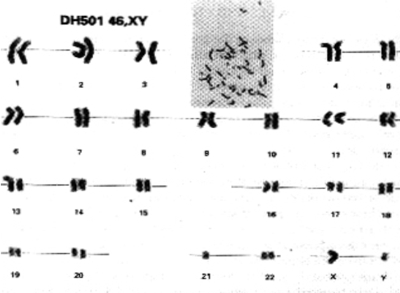The root of all inheritance is the gene. In general one gene encodes, or makes, one protein, which in turn catalyzes one biochemical reaction. Genes are so small they cannot easily be divided, so they usually are passed on intact from parent to child. Genes are found on long, threadlike molecules called chromosomes, which are located with in the nucleus of the cell. An average human chromosome, containing abut 4000 genes, is large enough that it can be seen with a light microscope.
Humans have two copies of each chromosome. One number of each pair is inherited from the mother, the other from the father. Each person has twenty three pairs of chromosomes: twenty two pairs called autosomes and one pair of sex chromosomes. The two numbers of each pair of autosomes are virtually identical; looking in the microscope it is impossible to tell which was derived from the mother and which from the father. The two sex chromosomes known as "X" and "Y" are noticeably different from one another; the X chromosome is relatively large and long where as the Y chromosomes is small and dumpy. Men and women share almost the same genetic make up, but males have an X and Y sex chromosome, while females have two copies of the X. The sex of an individual is determined by the presence or absence of the Y chromosome, not by the number of X chromosomes.
Fig. 16 shows the typical array of chromosomes found in the blood cells of a make, in this case a gay man. The chromosomes have been arranged into a karyotype, or a portrait of the chromosomes in order of size. Almost every cell in the body contains the same set of forty six chromosomes and thus the same genetic information, so each tiny cell contains all the information needed by the entire body. To make an analogy, each chromosome forms a single volume of a personalized set of encyclopaedias containing everything necessary to be human. The genes are like the individual articles found in each encyclopaedia.
 | Chromosomes from male and female come together during conception, when a sperm cell fertilizes an ovum. Sperm and ova are special type of cells, called germ cells that contain only one copy of each chromosome, instead of two. Only one of each pair of chromosomes—either the one herited from the mother or the one from the father—can end up in a germ cell, and the selection is determined purely by chance during a process called meiosis. Chance also dictates which of a large number of sperm cells with fuse with a particular ovum to form a fertilized egg cell. Once conception occurs and the male and female chromosomes have merged, all the cells in the new human will be almost exact copies of the original fertilized egg cell. Thus the genetic composition of a human depends on two throws of the dice, the first during the formation of the germ cells and the second at conception. These two actions suffle the genetic information so thoroughly that a child can have her father's nose and her mother's eyes and the other traits that seem to be a combination of both parents physical characteristic or characteristic that are 'gifts' from past generations.[137] |
 Prof. Dr. Sohan Raj Tater
Prof. Dr. Sohan Raj Tater
 Doctoral Thesis, JVBU
Doctoral Thesis, JVBU